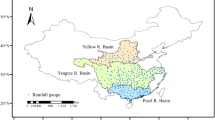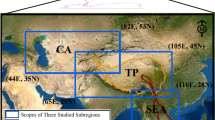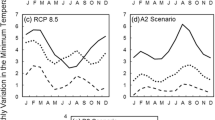Abstract
Climate change is expected to have severe impacts on natural systems as well as various socio-economic aspects of human life. This has urged scientific communities to improve the understanding of future climate and reduce the uncertainties associated with projections. In the present study, ten statistically downscaled CMIP5 GCMs at 1/16th deg. spatial resolution from two different downscaling procedures are utilized over the Columbia River Basin (CRB) to assess the changes in climate variables and characterize the associated uncertainties. Three climate variables, i.e. precipitation, maximum temperature, and minimum temperature, are studied for the historical period of 1970–2000 as well as future period of 2010–2099, simulated with representative concentration pathways of RCP4.5 and RCP8.5. Bayesian Model Averaging (BMA) is employed to reduce the model uncertainty and develop a probabilistic projection for each variable in each scenario. Historical comparison of long-term attributes of GCMs and observation suggests a more accurate representation for BMA than individual models. Furthermore, BMA projections are used to investigate future seasonal to annual changes of climate variables. Projections indicate significant increase in annual precipitation and temperature, with varied degree of change across different sub-basins of CRB. We then characterized uncertainty of future projections for each season over CRB. Results reveal that model uncertainty is the main source of uncertainty, among others. However, downscaling uncertainty considerably contributes to the total uncertainty of future projections, especially in summer. On the contrary, downscaling uncertainty appears to be higher than scenario uncertainty for precipitation.










Similar content being viewed by others
References
Abatzoglou JT, Brown TJ (2012) A comparison of statistical downscaling methods suited for wildfire applications. Int J Climatol 32:772–780. doi:10.1002/joc.2312
Abatzoglou JT, Rupp DE, Mote PW (2014) Seasonal climate variability and change in the Pacific Northwest of the US. J Clim 27:2125–2142. doi:10.1175/JCLI-D-13-00218.1
Ahmadalipour A, Rana A, Moradkhani H, Sharma A (2015) Multi-criteria evaluation of CMIP5 GCMs for climate change impact analysis. Theor Appl Climatol. doi:10.1007/s00704-015-1695-4
Ahmadalipour A, Moradkhani H, Svoboda M (2016) Centennial drought outlook over the CONUS using NASA-NEX downscaled climate ensemble. Int J Climatol. doi:10.1002/joc.4859
Berghuijs WR, Woods RA, Hrachowitz M (2014) A precipitation shift from snow towards rain leads to a decrease in streamflow. Nat Clim Change 4:583–586
Blázquez J, Nuñez MN (2013) Analysis of uncertainties in future climate projections for South America: comparison of WCRP-CMIP3 and WCRP-CMIP5 models. Clim Dyn 41:1039–1056
Boberg F, Christensen JH (2012) Overestimation of Mediterranean summer temperature projections due to model deficiencies. Nat Clim Change 2:433–436. doi:10.1038/nclimate1454
Cattiaux J, Douville H, Peings Y (2013) European temperatures in CMIP5: origins of present-day biases and future uncertainties. Clim Dyn 41:2889–2907. doi:10.1007/s00382-013-1731-y
Chen J, Brissette FP, Poulin A, Leconte R (2011) Overall uncertainty study of the hydrological impacts of climate change for a Canadian watershed. Water Resour Res 47. doi:10.1029/2011WR010602
Chen J, Brissette FP, Chaumont D, Braun M (2013) Performance and uncertainty evaluation of empirical downscaling methods in quantifying the climate change impacts on hydrology over two North American river basins. J Hydrol 479:200–214
Clark MP, Wilby RL, Gutmann ED, et al (2016) Characterizing uncertainty of the hydrologic impacts of climate change. Curr Clim Change Reports 2:55–64
Cooper MG, Nolin AW, Safeeq M (2016) Testing the recent snow drought as an analog for climate warming sensitivity of Cascades snowpacks. Environ Res Lett 11:84009
DeChant CM, Moradkhani H (2014) Toward a reliable prediction of seasonal forecast uncertainty: addressing model and initial condition uncertainty with ensemble data assimilation and sequential bayesian combination. J Hydrol 519:2967–2977
Demirel MC, Moradkhani H (2015) Assessing the impact of CMIP5 climate multi-modeling on estimating the precipitation seasonality and timing. Clim Change 135(2):357–372
Demirel MC, Booij M, Hoekstra A (2015) The skill of seasonal ensemble low-flow forecasts in the Moselle River for three different hydrological models. Hydrol Earth Syst Sci 19:275–291
Deser C, Phillips AS, Alexander M a., Smoliak BV (2014) Projecting North American climate over the next 50 years: uncertainty due to internal variability*. J Clim 27:2271–2296. doi:10.1175/JCLI-D-13-00451.1
Diffenbaugh NS, Scherer M, Ashfaq M (2013) Response of snow-dependent hydrologic extremes to continued global warming. Nat Clim Change 3:379–384
Duan Q, Phillips TJ (2010) Bayesian estimation of local signal and noise in multimodel simulations of climate change. J Geophys Res 115:D18123. doi:10.1029/2009JD013654
Etemadi H, Samadi S, Sharifikia M (2013) Uncertainty analysis of statistical downscaling models using general circulation model over an international wetland. Clim Dyn 42:2899–2920. doi:10.1007/s00382-013-1855-0
Eum H-I, Gachon P, Laprise R (2013) Developing a likely climate scenario from multiple regional climate model simulations with an optimal weighting factor. Clim Dyn 43:11–35. doi:10.1007/s00382-013-2021-4
Eum H-I, Cannon AJ, Murdock TQ (2016) Intercomparison of multiple statistical downscaling methods: multi-criteria model selection for South Korea. Stoch Environ Res Risk Assess 31:683. doi:10.1007/s00477-016-1312-9
Feng J, Lee D-K, Fu C, et al (2010) Comparison of four ensemble methods combining regional climate simulations over Asia. Meteorol Atmos Phys 111:41–53. doi:10.1007/s00703-010-0115-7
Ficklin DL, Barnhart BL, Knouft JH et al (2014) Climate change and stream temperature projections in the Columbia River basin: habitat implications of spatial variation in hydrologic drivers. Hydrol Earth Syst Sci 18:4897–4912
Ficklin DL, Abatzoglou JT, Robeson SM, Dufficy A (2016a) The influence of climate model biases on projections of aridity and drought. J Clim 29(4):1269–1285
Ficklin DL, Letsinger SL, Stewart IT, Maurer EP (2016b) Assessing differences in snowmelt-dependent hydrologic projections using CMIP3 and CMIP5 climate forcing data for the western US. Hydrol Res 47:483–500
Gleckler PJ, Taylor KE, Doutriaux C (2008) Performance metrics for climate models. J Geophys Res 113:D06104. doi:10.1029/2007JD008972
Gutmann E, Pruitt T, Clark MP et al (2014) An intercomparison of statistical downscaling methods used for water resource assessments in the US. Water Resour Res 50:7167–7186
Hawkins E, Sutton R (2010) The potential to narrow uncertainty in projections of regional precipitation change. Clim Dyn 37:407–418. doi:10.1007/s00382-010-0810-6
Hawkins E, Smith RS, Gregory JM, Stainforth DA (2015) Irreducible uncertainty in near-term climate projections. Clim Dyn. doi:10.1007/s00382-015-2806-8
Huang D, Zhu J, Zhang Y, Huang A (2013) Uncertainties on the simulated summer precipitation over Eastern China from the CMIP5 models. J Geophys Res Atmos 118:9035–9047
Huang S, Huang Q, Chang J, Leng G (2015) Linkages between hydrological drought, climate indices and human activities: a case study in the Columbia River basin. Int J Climatol. doi:10.1002/joc.4344
Isaak DJ, Wollrab S, Horan D, Chandler G (2012) Climate change effects on stream and river temperatures across the northwest US from 1980 to 2009 and implications for salmonid fishes. Clim Change 113:499–524
Jung I-W, Moradkhani H, Chang H (2012) Uncertainty assessment of climate change impacts for hydrologically distinct river basins. J Hydrol 466:73–87
Kapnick S, Hall A (2012) Causes of recent changes in western North American snowpack. Clim Dyn 38:1885–1899
Knutti R (2008) Should we believe model predictions of future climate change? Philos Trans A Math Phys Eng Sci 366:4647–4664. doi:10.1098/rsta.2008.0169
Knutti R, Sedláček J (2012) Robustness and uncertainties in the new CMIP5 climate model projections. Nat Clim Change 3:369–373. doi:10.1038/nclimate1716
Kwok R (2011) Observational assessment of Arctic Ocean sea ice motion, export, and thickness in CMIP3 climate simulations. J Geophys Res 116:C00D05
Li J, Zhang Q, Chen YD, Singh VP (2013) GCMs-based spatiotemporal evolution of climate extremes during the 21st century in China. J Geophys Res Atmos 118:11–17
Livneh B, Rosenberg EA, Lin C et al (2013) A long-term hydrologically based dataset of land surface fluxes and states for the conterminous US: update and extensions*. J Clim 26:9384–9392. doi:10.1175/JCLI-D-12-00508.1
Madadgar S, Moradkhani H (2014) Improved Bayesian multimodeling; integration of Copulas and BMA. Water Resour Res:1–18. doi:10.1002/2014WR015965.Received
Mankin JS, Diffenbaugh NS (2015) Influence of temperature and precipitation variability on near-term snow trends. Clim Dyn 45:1099–1116
Matheussen B, Kirschbaum RL, Goodman IA et al (2000) Effects of land cover change on streamflow in the interior Columbia River Basin (USA and Canada). Hydrol Process 14:867–885
Miao C, Duan Q, Sun Q, et al (2014) Assessment of CMIP5 climate models and projected temperature changes over Northern Eurasia. Environ Res Lett 9:55007. doi:10.1088/1748-9326/9/5/055007
Miao C, Su L, Sun Q, Duan Q (2016) A nonstationary bias-correction technique to remove bias in GCM simulations. J Geophys Res Atmos 121:5718–5735
Mizukami N, Clark MP, Gutmann ED et al (2016) Implications of the methodological choices for hydrologic portrayals of climate change over the contiguous US: statistically downscaled forcing data and hydrologic models. J Hydrometeorol 17:73–98
Mote PW, Salathé EP (2010) Future climate in the Pacific Northwest. Clim Change 102:29–50. doi:10.1007/s10584-010-9848-z
Najafi MR, Moradkhani H (2015) Multi-model ensemble analysis of runoff extremes for climate change impact assessments. J Hydrol 525:352–361. doi:10.1016/j.jhydrol.2015.03.045
Najafi MR, Moradkhani H, Jung IW (2011) Assessing the uncertainties of hydrologic model selection in climate change impact studies. Hydrol Process 25:2814–2826. doi:10.1002/hyp.8043
Pascale S, Lucarini V, Feng X, et al (2016) Projected changes of rainfall seasonality and dry spells in a high greenhouse gas emissions scenario. Clim Dyn 46:1331–1350
Perez J, Menendez M, Mendez FJ, Losada IJ (2014) Evaluating the performance of CMIP3 and CMIP5 global climate models over the north-east Atlantic region. Clim Dyn 43:2663–2680. doi:10.1007/s00382-014-2078-8
Raftery AE, Gneiting T, Balabdaoui F, Polakowski M (2005) Using Bayesian model averaging to calibrate forecast ensembles. Mon Weather Rev 133:1155–1174. doi:10.1175/MWR2906.1
Rana A, Moradkhani H (2015) Spatial, temporal and frequency based climate change assessment in Columbia River Basin using multi downscaled-Scenarios. Clim Dyn 47:579. doi:10.1007/s00382-015-2857-x
Rana A, Moradkhani H, Qin Y (2016) Understanding the joint behavior of temperature and precipitation for climate change impact studies. Theor Appl Climatol 1–19. doi:10.1007/s00704-016-1774-1
Reintges A, Martin T, Latif M, Keenlyside NS (2016) Uncertainty in twenty-first century projections of the Atlantic Meridional Overturning Circulation in CMIP3 and CMIP5 models. Clim Dyn 1–17. doi:10.1007/s00382-016-3180-x
Robine J-M, Cheung SLK, Le Roy S et al (2008) Death toll exceeded 70,000 in Europe during the summer of 2003. C R Biol 331:171–178
Rupp DE, Abatzoglou JT, Hegewisch KC, Mote PW (2013) Evaluation of CMIP5 20th century climate simulations for the Pacific Northwest USA. J Geophys Res Atmos 118:10,884–10,906. doi:10.1002/jgrd.50843
Rupp DE, Abatzoglou JT, Mote PW (2016) Projections of 21st century climate of the Columbia River Basin. Clim Dyn 1–17. doi:10.1007/s00382-016-3418-7
Shukla S, Safeeq M, Aghakouchak A, et al (2015) Temperature impacts on the water year 2014 drought in California, 1–10. doi:10.1002/2015GL063666.Received
Sillmann J, Kharin VV, Zhang X et al (2013) Climate extremes indices in the CMIP5 multimodel ensemble: Part 1. Model evaluation in the present climate. J Geophys Res Atmos 118:1716–1733. doi:10.1002/jgrd.50203
Sima S, Ahmadalipour A, Tajrishy M (2013) Mapping surface temperature in a hyper-saline lake and investigating the effect of temperature distribution on the lake evaporation. Remote Sens Environ 136:374–385
Sun Q, Miao C, Duan Q (2016) Extreme climate events and agricultural climate indices in China: CMIP5 model evaluation and projections. Int J Climatol 36:43–61
Taylor KE (2000) Summarizing multiple aspects of model performance in a single diagram. Program for Climate Model Diagnosis and Intercomparison, Lawrence Livermore National Laboratory, University of California
Thibeault JM, Seth A (2014) A framework for evaluating model credibility for warm-season precipitation in Northeastern North America: a case study of CMIP5 simulations and projections. J Clim 27:493–510. doi:10.1175/JCLI-D-12-00846.1
Vano JA, Nijssen B, Lettenmaier DP (2015) Seasonal hydrologic responses to climate change in the Pacific Northwest. Water Resour Res 51:1959–1976
Wang D, Hagen SC, Alizad K (2013) Climate change impact and uncertainty analysis of extreme rainfall events in the Apalachicola River basin, Florida. J Hydrol 480:125–135. doi:10.1016/j.jhydrol.2012.12.015
Werner AT, Cannon AJ (2016) Hydrologic extremes-an intercomparison of multiple gridded statistical downscaling methods. Hydrol Earth Syst Sci 20:1483
Woldemeskel FM, Sharma A., Sivakumar B, Mehrotra R (2012) An error estimation method for precipitation and temperature projections for future climates. J Geophys Res Atmos 117. doi:10.1029/2012JD018062
Wood AW, Leung LR, Sridhar V, Lettenmaier DP (2004) Hydrologic implications of dynamical and statistical approaches to downscaling climate model outputs. Clim Change 62:189–216
Acknowledgements
Partial financial support for this study was provided by the DOE, cooperative agreement 00063182.
Author information
Authors and Affiliations
Corresponding author
Electronic supplementary material
Below is the link to the electronic supplementary material.
Rights and permissions
About this article
Cite this article
Ahmadalipour, A., Moradkhani, H. & Rana, A. Accounting for downscaling and model uncertainty in fine-resolution seasonal climate projections over the Columbia River Basin. Clim Dyn 50, 717–733 (2018). https://doi.org/10.1007/s00382-017-3639-4
Received:
Accepted:
Published:
Issue Date:
DOI: https://doi.org/10.1007/s00382-017-3639-4




